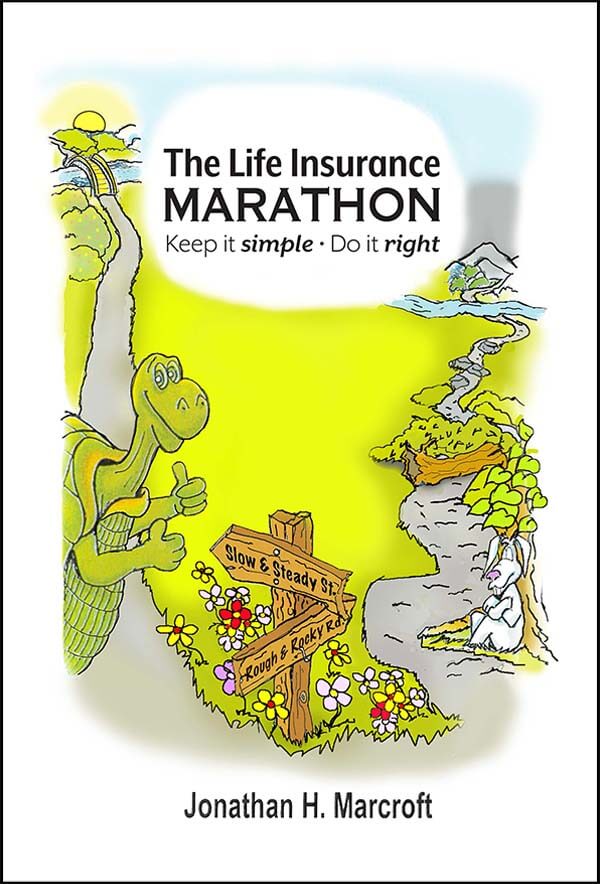
If you’re like me, from time to time you find yourself at the store going back and forth between two products that deliver something similar. One of them offers a better experience, or some type of guarantee, while the other is just what it is – and if it doesn’t work, or doesn’t work right, there is really no recourse. They are also differentiated in price, as a better experience and a guarantee will always require more money. Sometimes I buy both and try the inexpensive one first, and if it works for me, I return the more expensive version.
Sadly, we can’t do that with life insurance. Or, can we?
At the end of this article you will have the opportunity to receive 5 FREE chapters from The Life Insurance Marathon.
The Ugly Duckling and the Cheap Fix
The Story of the Participating Whole Life Insurance Policy
DO YOU REMEMBER THE story of the Ugly Duckling? It is a beautiful tale of transformation. A mother duck is raising her brood of ducklings, but one of them is different. It is awkward and ugly; an unattractive misfit. The other ducklings tease and chide the ugly duckling to no end. As the story goes, the young misfit, who had been misidentified as a duck, grows over time into a great swan — the most beautiful and graceful of all water fowl!
I have always loved this classic tale for its endearing humanity. Its simple and timeless message resonates with anyone who has ever felt out of place, or misunderstood. And, believe it or not, it is also the story of the participating whole life insurance policy.
 In recent decades, whole life has become the ugly duckling amongst life insurance products. The reasons are simple: it’s more expensive to the budget, making it ugly; and it’s slow to grow, making it a misfit. In today’s financial products world, consumers demand more for their purchasing dollars. We want everything financial to offer reasonably strong growth potential. That’s a rational expectation if we’re talking about a 401(k), an IRA, or some other type of long-term investment account involving some risk. But it’s not a good fit for life insurance. As stock markets have increased in popularity, consumers have begun to apply investment principals and expectations to financial products that never had a history in stock markets.
In recent decades, whole life has become the ugly duckling amongst life insurance products. The reasons are simple: it’s more expensive to the budget, making it ugly; and it’s slow to grow, making it a misfit. In today’s financial products world, consumers demand more for their purchasing dollars. We want everything financial to offer reasonably strong growth potential. That’s a rational expectation if we’re talking about a 401(k), an IRA, or some other type of long-term investment account involving some risk. But it’s not a good fit for life insurance. As stock markets have increased in popularity, consumers have begun to apply investment principals and expectations to financial products that never had a history in stock markets.
Life insurance companies caught on to this consumer trend in the 1980s and started inventing products to fulfill consumer demand. Essentially, life insurance companies have instituted a Frankenstein-design approach to life insurance policies for the purpose of attracting consumer spending. These newer products create a ton of profit for life insurance companies due to their non-guaranteed designs (see the previous chapter, Beware the Gambler).
But life insurance, by its very nature, is not on the strong-growth side of the financial product ledger. It is meant to be slow, steady and safe because it’s life insurance! If your job is walking the high wire at the circus, you need the safety net below to be strong, steady and stable. Though the net is vital to your safety and security, and therefore it is an important part of your act, it is boring and goes largely unnoticed by almost everybody. Nevertheless, it’s your protection, and if you ever need it, everybody will be grateful it was there.
Participating whole life is, hands down, the highest quality life insurance policy, financial safety net or financial back-up plan, on the market. Given enough time, it is also the least expensive to own. Many participating whole life policies reach breakeven between 12 and 15 years. At that point, you begin to make a profit. Participating whole life is the only life insurance product that can offer this type of return and provide a guaranteed death benefit together with a guaranteed level-premium payment.
Use my life insurance wizard, PolicyQuest to discover what type of life insurance policy is best for your situation. It takes just a few minutes.
Participating Whole Life
“Participating” means participation in favorable performance or profits, through dividend payments. When a life insurance company posts an annual profit, a policy dividend is declared. As an owner of a participating whole life policy, you share in the annual profit by receiving a dividend based on a few factors, one of them being your policy’s accumulated cash value. In the early years, your cash value, and therefore your dividend, will be low. As your cash value grows over time, your dividend payments will also grow; they will eventually represent a significant amount of money. While dividend payments are not guaranteed, historically speaking, participating whole life policies have consistently delivered annual dividends to policy owners.
There are several ways to receive your dividend:
- Cash – you will receive an annual dividend check.
- Reduced premium – your dividend will be credited as premium and will reduce your premium payment for that year.
- Paid-up additions – your dividend will pay in-full for additional life insurance coverage; the additional life insurance will also qualify for future dividends.
- At interest – your dividend is deposited into a savings account with your life insurance company and it grows at interest.
Seems like a no-brainer, right? But then you see the price tag. The greatest obstacle to the purchase of a large whole life policy is affordability. Most people cannot afford to place all of their life insurance needs into whole life, regardless of the benefits. But there is a way to enjoy the benefits of participating whole life without blowing up your budget.
The Cheap Fix
Buyer’s remorse is something we all endure from time to time. “That ice cream looked so good, but it’s not what I expected. Why didn’t I ask for a sample taste before I bought it?” Or, “I really love the look of these shoes, but they hurt my feet after just a short time. I wish I had been more careful before I bought them.”
Experiences like these are common. We make assumptions, and we let our emotions guide our purchasing behavior. While shoes that don’t quite fit and ice cream that doesn’t taste how we expected would be disappointing, these experiences don’t impact us much. Ice cream and shoes are small purchases. Our buyer’s remorse subsides quickly and we move on, hopefully a little wiser. But with life insurance, you could commit many thousands of dollars to a policy before discovering you purchased the wrong product for your situation.
Nearly everybody needs life insurance. Most people appreciate the value of whole life insurance after just a small amount of unbiased research. So, how do you obtain an affordable whole life policy that fits your needs and will grow enough over time so you can receive all of your money back?
Subscribe to receive 5 FREE chapters including this chapter. This full chapter will be delivered to your inbox immediately. Then, over the next 4 weeks, you’ll receive one FREE chapter per week. We will NEVER spam you. We NEVER share your information with 3rd parties. You will not be bothered by a salesperson. And it’s easy to unsubscribe.
Once you begin to understand life insurance, you can take steps to properly protect your loved ones. It’s much easier than most people think!
Cheers!

>>Get the entire book, The Life Insurance Marathon, on Amazon.com.
>>Ready now to get a free quote via email (no salesperson)? Try it here.
>>How much protection does your family need? Find out here.
>>Try PolicyQuest. Find out what type of life insurance policy is best for your situation.
